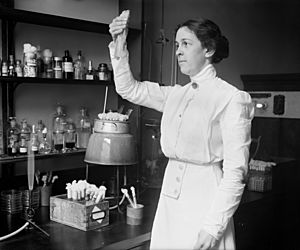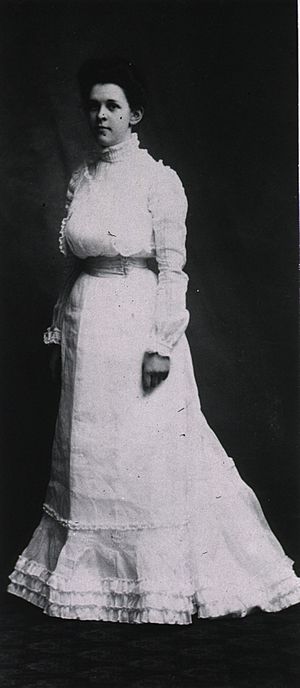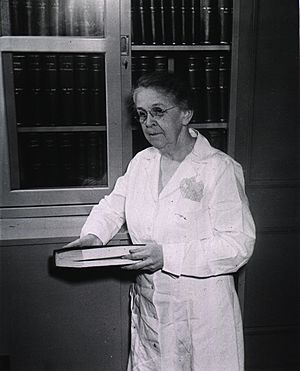Alice Catherine Evans facts for kids
Quick facts for kids
Alice Catherine Evans
|
|
|---|---|
 |
|
| Born | January 29, 1881 Neath, Pennsylvania
|
| Died | September 5, 1975 (aged 94) |
| Nationality | American |
| Alma mater | Susquehanna Collegiate Institute Cornell University University of Wisconsin–Madison |
| Known for | Demonstrating that Bacillus abortus caused brucellosis |
| Scientific career | |
| Institutions | US Department of Agriculture United States Public Health Service |
Alice Catherine Evans (born January 29, 1881 – died September 5, 1975) was an American microbiologist. She studied tiny living things like bacteria. Alice worked as a researcher for the US Department of Agriculture.
She looked into bacteria found in milk and cheese. Her most important discovery was showing that a germ called Bacillus abortus caused a disease called brucellosis. This disease affected both cattle (cows) and humans.
Contents
Early Life and School
Alice Evans was born on a farm in Neath, Bradford County, Pennsylvania. She was the younger of two children. Her father, William Howell, was a farmer, and her mother, Anne B. Evans, was a teacher.
Alice was taught at home by her parents when she was five and six years old. Then, she went to a one-room school in Neath. She earned excellent grades there.
She later attended the Susquehanna Collegiate Institute. While there, she played on a women's basketball team. Basketball was new for women then, and some people were surprised by the sport.
After finishing school, Alice became a teacher. She wrote in her memoirs that teaching was the only job open to women at the time. However, she found it quite boring.
After four years, she took a free course at Cornell University. This course was for teachers from rural areas. It aimed to help them make science and nature exciting for their students.
Alice received a scholarship and wanted to keep studying science. Cornell offered free tuition for bacteriology. This was to encourage students to learn about this new science. Alice worked hard to pay for her studies. She earned her bachelor's degree in bacteriology from Cornell in 1909. She then received a scholarship from the University of Wisconsin–Madison. She earned her master's degree there the next year.
Important Discoveries
Alice Evans got a job with the US Department of Agriculture (USDA). She worked in the Dairy Division in Madison, Wisconsin. She spent three years there. Her work involved making cheese and butter taste better. She also looked for sources of bacteria in milk products.
Alice was the first woman scientist to have a permanent job as a bacteriologist at the USDA. This meant her job was protected by law. Each year, she took a university course. She learned German so she could read research reports from Germany.
In 1913, Alice moved to Washington, D.C. The USDA had a new building there. She found the Dairy Division welcoming. While there, she worked with other important scientists.
Alice became very interested in the disease brucellosis. She wondered how it was connected to fresh, unpasteurized milk. She studied a germ called Bacillus abortus. This germ was known to cause miscarriages in animals. Alice found that the germ lived in infected cows, even those that looked healthy.
She thought that since the bacteria was in cow's milk, it could harm humans. Alice decided to investigate this idea. She wondered if the disease in cows could cause undulant fever in people. She warned that raw milk should be pasteurized. This would protect people from various diseases.
She shared her findings with the Society of American Bacteriologists in 1917. She also published her work in a science journal in 1918. Some people were doubtful, especially because she was a woman and did not have a Ph.D. Alice decided to let her findings be tested over time.
In April 1918, Alice joined the United States Public Health Service's Hygienic Laboratory. She began studying meningitis. This was a serious disease during World War I. In October 1918, the Spanish flu reached Washington, D.C. Alice was asked to study the flu instead. She got sick with the flu early in her research.
Later, she studied Streptococcus. This germ spread among soldiers returning from World War I. Her studies of streptococci continued for many years.
In 1920, other scientists confirmed Alice's discovery. They agreed that cow's milk was a source of human brucellosis. More outbreaks in 1922 led Alice to continue her research. She studied blood samples and infected a cow to learn more. Her work was confirmed many times, even with some scientists being doubtful.
Alice herself got sick with undulant fever in October 1922. This disease was incurable at the time. It affected her health for twenty years. Doctors first thought she had another illness. But in 1928, they found the Brucella germ in her body. This confirmed her diagnosis.
Eventually, Brucella was proven to be the cause of undulant fever and Malta fever. In 1928, the Society of American Bacteriologists elected Alice as their president. She was the first woman to hold this position. Alice's discoveries led to milk pasteurization becoming common in 1930. This greatly reduced brucellosis in the United States.
Because of her health, Alice stopped working with brucellae for a while. In 1936, she started again, but did not handle the live germs. She studied three cities to find signs of brucellar infection.
From 1939 until her retirement in 1945, Alice focused on Hemolytic streptococcus.
In 1969, Alice gave a collection of her papers to the National Library of Medicine.
After Retirement
Alice officially retired in 1945. However, she kept working in her field. After retiring, she became a popular speaker. She often spoke to women's groups. She encouraged women to pursue careers in science.
Sixteen years after retiring, Alice started writing about brucellosis again. She encouraged more studies into the disease.
Alice Evans passed away on September 5, 1975, in Alexandria, Virginia. She was 94 years old. Her tombstone has a special message: "The gentle hunter, having pursued and tamed her quarry, crossed over to a new home."
Awards and Honors
- First female president of the Society of American Bacteriologists, elected in 1928
- Received an honorary medical degree from Woman's Medical College of Pennsylvania, 1934
- Received honorary science degrees from University of Wisconsin–Madison and Wilson College, 1936
- Fellow, American Association for the Advancement of Science
- Honorary president, Inter-American Committee on Brucellosis, 1945–57
- Honorary member, American Society for Microbiology, 1975
- Inducted into the National Women's Hall of Fame, 1993
- A bacterium, Enemella evansiae, was named after her in 2020
Images for kids
See also
 In Spanish: Alice Catherine Evans para niños
In Spanish: Alice Catherine Evans para niños




